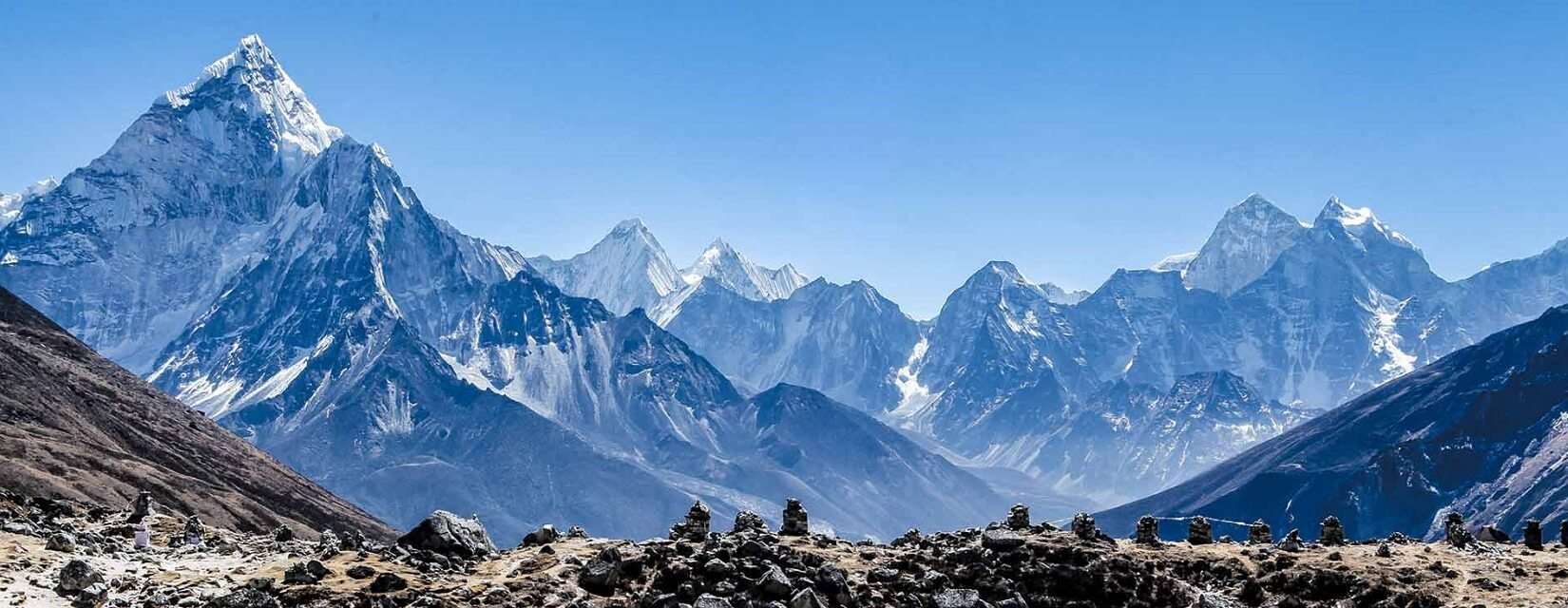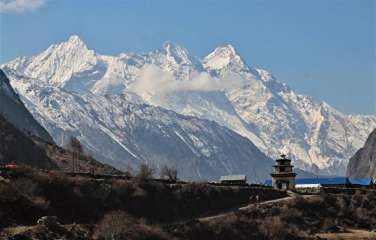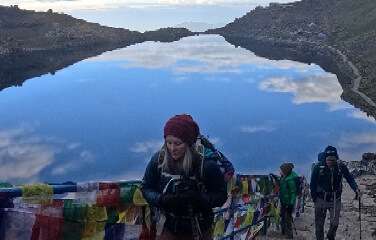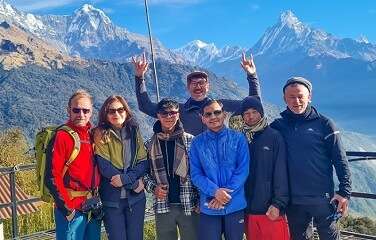Majestic Himalayan Range

Nepal boasts eight of the world’s fourteen highest peaks, including Mount Everest, the tallest at 8,848.86 meters. The sight of these towering giants is enough to captivate any trekker. Trails like the Everest Base Camp Trek and Annapurna Circuit bring you face-to-face with these majestic peaks, offering once-in-a-lifetime panoramic views.
Diverse Trekking Routes
From high-altitude expeditions to scenic lowland treks, Nepal caters to all levels of trekking experience:
- Classic Treks: Everest Base Camp, Annapurna Circuit, and Langtang Valley.
- Off-the-Beaten-Path: Manaslu Circuit, Upper Mustang, and Nar Phu Valley.
- Challenging Climbs: Island Peak, Mera Peak, and Tent Peak (Tharpu Chuli).
- The diversity of trails ensures there's something for everyone, whether you seek adventure, solitude, or cultural immersion.
Stunning Natural Beauty

Nepal’s landscapes are a dream for nature lovers. Expect snow-capped mountains, lush forests, terraced fields, and glacial rivers. Trekking in Nepal offers the chance to traverse varied ecosystems, from subtropical jungles to alpine meadows. Trails like the Mardi Himal Trek and Gokyo Lakes Trek showcase this natural diversity in its full glory.
Cultural Richness

Trekking in Nepal is not just about the mountains; it’s also an opportunity to immerse yourself in the country’s rich cultural tapestry. The trails wind through remote villages where you can experience the hospitality of diverse ethnic groups like the Sherpas, Gurungs, and Tamangs. Ancient monasteries, fluttering prayer flags, and Mani walls add a spiritual dimension to your journey.
Adventure and Accessibility
Nepal offers a wide range of trekking experiences, from easy to strenuous. Many of its most iconic trails are supported by well-established infrastructure, including teahouses, guides, and porters, making even remote areas accessible. Whether you're trekking solo or with a group, Nepal provides a safe and adventurous environment.
Affordable Travel
Nepal remains one of the most cost-effective trekking destinations. The cost of permits, accommodation, and food is relatively low compared to other trekking destinations. Guided treks and porter services are also affordable, making it easier for trekkers to focus on the journey rather than logistics.
Unique Experiences
Nepal’s trekking routes offer unique experiences beyond just walking:
- Cross-challenging passes like Thorong La and Kongma La.
- Witness rare wildlife in regions like the Annapurna Conservation Area.
- Combine trekking with climbing on peaks like Lobuche East or Tharpu Chuli.
- Visit sacred landmarks like Muktinath Temple or Gosainkunda Lake.
Community and Connections
Trekking in Nepal fosters connections—both with fellow trekkers and the local communities. Sharing stories around a teahouse fire or witnessing villagers celebrate local festivals like Dashain and Tihar are moments that deepen the trekking experience.
Season-Friendly Treks

Nepal’s trekking seasons cater to all preferences.
- Spring (March-May): Ideal for rhododendron blooms and moderate temperatures.
- Autumn (September-November): Clear skies and the best mountain views.
- Winter (December-February): Fewer crowds and serene trails, though high passes might be snowbound.
- Monsoon (June-August): Perfect for rain-shadow areas like Upper Mustang and Dolpo.
Choosing the Right Trek
- For Beginners: Start with shorter, less challenging treks like the Ghorepani Poon Hill Trek or the Langtang Valley Trek. These trails are easier to navigate, with plenty of amenities along the way.
- For Intermediate Trekkers: Trails like the Annapurna Base Camp Trek or Everest Base Camp Trek provide moderate challenges with rewarding views.
- For Advanced Trekkers: Consider technical routes such as the Manaslu Circuit with Tsum Valley, Makalu Base Camp Trek, or even climbing peaks like Island Peak.
Permits and Regulations
Nepal has regulations in place to ensure safety and conservation. Common permits include:
- TIMS Card (Trekkers' Information Management System)
- Conservation Area Permits, such as the Annapurna Conservation Area Permit (ACAP) or Sagarmatha National Park Permit
- Restricted Area Permits for regions like Upper Mustang, Manaslu, or Dolpo
Be sure to check the requirements for your chosen trek and organize these permits in Kathmandu or Pokhara before starting.
Hiring Guides and Porters
While many trails are straightforward, hiring a guide and/or porter enhances your experience. Guides provide valuable insights into the terrain, culture, and safety, while porters ease your load, allowing you to focus on the trek itself. In certain regions like Upper Mustang or Tsum Valley, a guide is mandatory.
Health and Safety Tips
- Acclimatization: Follow a gradual ascent to prevent altitude sickness. Many treks include rest days for this purpose.
- Hydration and Nutrition: Drink plenty of water and eat energy-rich foods to maintain stamina.
- First-Aid Kit: Always carry essentials like altitude sickness medication, bandages, and pain relievers.
- Travel Insurance: Ensure your policy covers high-altitude trekking and emergency evacuations.
Packing Essentials
Your packing list will depend on the season and trek, but key items include:
- Sturdy trekking boots and moisture-wicking clothing
- Warm layers, including a down jacket and thermal wear
- Sleeping bag rated for sub-zero temperatures (if not provided by teahouses)
- Trekking poles, sunglasses, sunscreen, and a hat
- Reusable water bottles and purification tablets
Post-Trek Exploration
After your trek, indulge in Nepal’s other attractions:
- Explore Kathmandu’s UNESCO World Heritage Sites, like Pashupatinath Temple, Boudhanath Stupa, and Durbar Square.
- Relax in Pokhara by the serene Phewa Lake or visit the World Peace Pagoda.
- Extend your adventure with activities like paragliding, white-water rafting, or a jungle safari in Chitwan National Park.
A Responsible Trekker’s Mindset
Nepal’s pristine environment and vibrant communities rely on sustainable tourism. Be a responsible trekker by:
- Adhering to the Leave No Trace principles.
- Respecting local customs and traditions.
- Supporting local businesses by staying in teahouses and hiring local guides.
The Call of Nepal

Every trekker who sets foot in Nepal carries home not just memories but a piece of its spirit—a spirit of resilience, adventure, and connection to the mountains. Nepal's trekking trails are more than just paths; they are gateways to self-discovery, cultural immersion, and the unparalleled beauty of the Himalayas.
There’s a reason why trekkers keep coming back to Nepal. Once you’ve experienced its magic, the mountains call you again and again.
So why wait? The ultimate trekking destination awaits your footprints. Come, explore Nepal, and let its trails transform you forever.
A Trekker's Legacy
Nepal is where legends like Sir Edmund Hillary and Tenzing Norgay etched their names in mountaineering history. Walking the same paths as these pioneers inspires a sense of achievement and connection to the larger trekking community.
Conclusion
Nepal is more than a destination—it’s a journey into the soul of the Himalayas. Its breathtaking trails, warm hospitality, and rich traditions make it the ultimate haven for trekkers. Whether you're chasing the thrill of high-altitude trekking or seeking a deeper connection with nature and culture, Nepal offers an experience like no other.
So pack your boots, prepare your spirit, and let Nepal guide you through its incredible landscapes. Your ultimate trekking adventure awaits!





